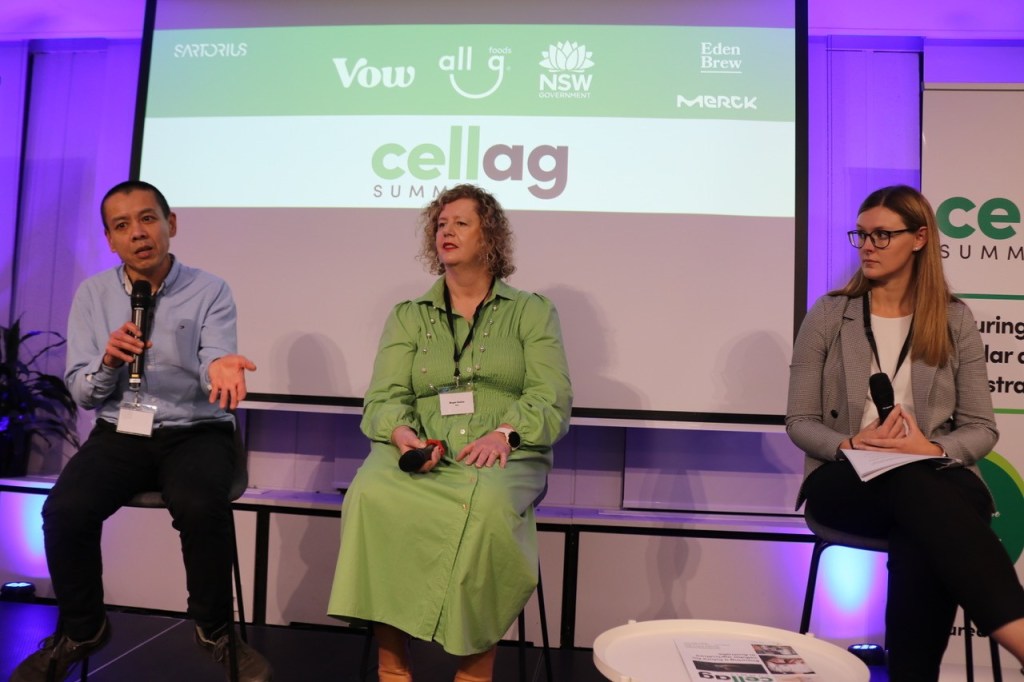The fact that they don’t yet have products to sell is irrelevant; cellular agriculture companies need to be devising their marketing strategies now.
At this stage, it’s looking like Australia could welcome its first cellular agriculture product, whether it be cultivated quail or cow-free dairy milk, before the close of 2024. It’s an incredibly exciting time, as we prepare to introduce a whole new category of food to the public.
And while companies including Vow, Magic Valley, All G Foods and Eden Brew most certainly have their plates full – jumping through regulatory hurdles, refining their products and working to scale up while driving costs down, they also need to be putting significant energy into how they’re actually going to sell their products, once they land on restaurant menus or supermarket shelves.
A resounding take-home message from the recent CellAg Summit, hosted by Future Alternative together with Cellular Agriculture Australia, is that getting consumers on-board – and early – is crucial. All the time, money and effort invested in making these novel food technologies a commercial reality will be wasted if no one wants to spend their hard earned dollars on them.
It’s important to note that not a lot of data exists on exactly how Australian consumers feel about cell ag products. Food Frontier, Australia and New Zealand’s alternative protein industry think tank, recently released data on consumer awareness and perception in five key Asian markets, but unfortunately, the same insights aren’t yet available for Australia.

Based on the local data we do have access to, we know that:
- About 12 percent of Australians answered the following question positively: “Have you tried or are you interested in trying cell-based meat?” (Mintel)
- In terms of the acceptance of cell-based meat, Australia sits about one-third of the way down the list of 36 countries Mintel conducts its research in.
- According to recent Food Standards Australia New Zealand (FSANZ) data (2000 respondents), 65 percent of Australian and New Zealand consumers have heard of cell-based meat, and 48 percent have heard of cell-based dairy, but only five percent know enough about it to explain it to a friend.
- 30 percent of the FSANZ respondents rated their confidence in the safety of cell-based meat as one out of seven, with seven being the most confident.
- Around half of the FSANZ respondents said they wouldn’t be willing to try cell-based meat at the moment, but the other half is somewhat open to it, with about 23 percent saying they would be willing to try it, and 29 percent unsure.
With this information in mind, and based on their extensive experience in consumer research and purchasing behaviours, three industry experts took the stage at the CellAg Summit to share their insights into exactly how cell ag companies should be approaching their go-to-market strategies.
Here’s what they had to say.
1. Consumers don’t buy on sustainability
It might be a key motivation for entrepreneurs, but when it comes to purchasing decisions, Australian consumers, in general, don’t buy based on sustainability.
According to Megan Stanton, Mintel’s Associate Director South APAC, Food and Drink and Purchase Intelligence Insights, about 53 percent of Australian consumers recognise that cellular agriculture offers environmental benefits, but that’s unlikely to translate at the checkout.

“That’s quite a high number of consumers. However … we know that consumers don’t buy on environmental benefits; they buy on taste, on health and nutrition, and on price. So consumers understand that these products have a benefit for the environment, but they don’t see the benefit attaching directly to themselves. That’s the biggest problem we have: the benefit [of cellular agriculture] for the consumer still seems quite out there. It doesn’t hit them where their pocket or their health sits right now,” she said.
Gie Liem, an Associate Professor specialising in sensory and consumer science at Deakin University, agrees, and said that for a product to really resonate, it needs to benefit the individual first and foremost.
“One of the things that we see consistently across markets and across different products is that when you talk about consumer benefit … if a product is very beneficial for somebody or something else, like animals, or it’s very beneficial for later, like with sustainability, then it’s actually not that important to consumers. What consumers care most about is themselves and what happens now, so that’s good price, good taste and good health.”
2. Consumers trust science and systems, but intentions matter
Trust is critical to consumers’ purchasing behaviours, and according to Stanton, Australians have the upmost faith in the food regulatory system. As much as the cell ag sector would like to see their products progress through the approval process as quickly as possible, Australians need to feel confident that the appropriate due diligence has been conducted.
“The time it takes to get the product right – regulatorily – is definitely important because that trust element, which is very closely linked with familiarity, is something that consumers already [have] with Australian food and drink. They trust the regulatory framework, so we need to take the time to get it right,” she said.

Importantly, Stanton added, Australians don’t actually understand how a lot of the food they consume ends up on their plate, but they’re still happy to eat it, because they trust the approval process it was subject to. This is obviously an important point for cellular agriculture companies, which are using novel technologies that are, in many cases, completely unfamiliar to the average consumer.
According to Liem, the majority of Australians say they trust science, and while this also might seem reassuring for companies handling emerging food technologies, what matters most here is intention.
“Consumers aren’t stupid. They know if you’re trying to sell something, and that’s where the distrust comes in … So about 70 percent of people say they trust science, but that’s more medical science, where they think the scientists are there for us, not themselves. When you look at GMOs for example, only 40 percent of people have trust in GMOs, and one of the reasons is that they don’t trust that the people who are putting GMOs on the market are doing it for us; they’re doing it to make money. And once you’re in that sort of area, you’re in trouble,” Liem said.
He urged cell ag companies to steer clear of marketing messages that suggest a brand is financially motivated, or which focus on the technology used to develop a new product.
“Research shows that when you say a product is high tech, humans don’t trust it. They don’t understand technology, so when the focus is on technology, [the product is seen as] unnatural, and when it’s unnatural, it’s not healthy. Those links are quite strong, and you see it in different consumer markets.”
3. If it’s done badly, it sticks
Stephanie Dolman, FSANZ’s senior social scientist, pointed to data from the CSIRO which looked at the key barriers to the uptake of novel proteins. According to the data, only 20 percent of people listed a lack of information as a being a major concern.
“So you’ve got a lot of people who are making up their minds about these products in a vacuum, and they don’t feel like they need more information to be able to make those [purchasing] decisions.

“I think it’s important that the industry is active in getting the right information out there,” she said.
Stanton agreed emphatically, and like Liem, pointed to GMOs as a relevant case study. She said concerns around GMO products are still exactly the same as they were when the products were first released in the 90s.
“The message here is if it’s done badly, it sticks,” she said.
Stanton said that the industry needs to take and keep control of the narrative surrounding its products, because if it doesn’t, someone else will.
“So originally in the US, you had to label a product only if it contained a genetically modified ingredient. Then we saw that the supermarkets got on-board and said they wanted their suppliers to make sure that none of the products they had on their shelves contained GM materials. So we ended up with a system where now we’re labelling things as GMO-free when in fact they never had genetically modified material in the first place. We generated a system where the labelling took over reality. We had consumers seeking GMO-free oranges and GMO-free water. They never existed.
“That’s what we need to be very concerned about. If there’s a vacuum, and there’s no information in the vacuum, it will get filled. It just wont get filled by us; it’ll get filled by the people who have another message to sell.”
To stay up-to-date on the latest industry headlines, sign up to Future Alternative’s enewsletter.
Posted on:


